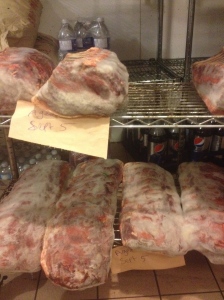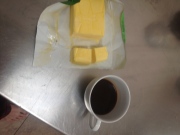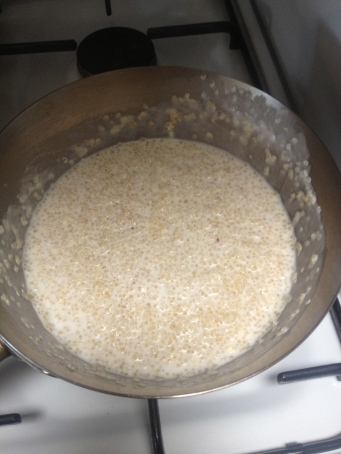Dry brining is the most important step in the whole process. After you’ve aged your steak, put it on a plate and season with salt on both sides (use quite a bit) and put it back in the fridge uncovered. Do this on the morning you are going cook your steak. The salt draws out any moisture left in the steak, it pools on top and eventually the salty liquid will seep back in. This seasons the meat on the inside. Even if you have a crappy piece of meat with no age and are planning to cook the shit out of it on BBQ, this step will make it taste twice as good.
Category Archives: Uncategorized
Herbs ARE the secret ingredient.
Thats all there is to it.
One of the common themes in the best restaurants I’ve worked in is the use of a lot of fresh herbs.
Get a few flavour combinations under your belt and it will give your food complexity and class.
I think the main reasons that most home cooks don’t use many herbs are that they are expensive, they don’t keep well and they’re time consuming to pick, wash and store.
The best solution is to grow your own. Invest in seeds, pick what you need and there’s no need to wash organic herbs that you’ve grown yourself unless your dog pees on the garden. I’m no expert on gardening but I reckon now would be a good time to plant your herbs.
We have lemon thyme, Italian flat leaf parsley, rosemary and mint growing in the garden all year round. We grow basil and chillies in summer and that’s about it. These herbs are versatile and easy to grow, and we use them in our everyday cooking.
Occasionally I’ll buy some herbs from the shop, but only to let ours regenerate.
If you do buy herbs from the shop it’s a good idea to pick the leaves into a sink of cold water. It regenerates and washes them at the same time. Put them through the salad spinner then into a container with dry paper towel on the bottom and damp paper towel on top. This keeps them fresh and crisp for a surprisingly long time. Make sure you give the leaves plenty of room in the container, if they’re packed too tight they will decompose sooner.
As a general guide, eat lighter herbs (such as coriander, parsley, basil and mint) fresh, in salads or salsas and cook the heaver herbs (such as rosemary, thyme and bay leaves) with meats or roast vegetables.Put combinations of mint, parsley, dill, coriander and tarragon into your mixed leaves. Season with salt, lemon juice and olive oil. Cook meats with butter, thyme or rosemary. It will add a whole new dimension to your cooking, and is sure to impress.
Bulletproof Coffee……. Oh Buddy.
Bulletproof coffee is: Coffee, Organic grass-fed butter and MCT oil blended together. It is amazing. MCT oil is found in coconut oil (that’s what I use) and is the next best thing if you don’t have the pure extract ( http://www.upgradedself.com/upgraded-mct-oil.html). Sometimes I just drink coffee with butter.
Bulletproof coffee is the trademark of Dave Asprey. Asprey is the founder and author of the biohacking site Bulletproof Executive and podcasts Bulletproof Radio. I highly recommend both and suggest you take a look at the original post on the Bulletproof Coffee recipe.
http://www.bulletproofexec.com
https://itunes.apple.com/au/podcast/bulletproof-executive-radio/id451295014
I have been on Bulletproof coffee for about a week now and it has made a huge difference. I’m not sure if Bulletproof coffee is good for everyone, but I’m 100% sure it’s good for me. I noticed the difference instantly. I have increased my focus (therefore my productivity), I have more consistent energy and less hunger (without overeating the night before or interrupting the balance of my hormones). The effects of the coffee usually last about 3-4 hours. Thats solid, uninterrupted work. Also, because I’ve been interested in intermittent fasting lately Bulletproof Coffee has been very important. Check out Bulletproof fasting if you’re interested.
Did I mention it tastes amazing?
Super Breakfast
Quinoa Porridge with Banana and Coconut Milk.
For those of you eating breakfast, this is a ripper for the winter months. Hayley and I started making it a couple of months back when we were first playing around with the Perfect Health Diet.
Quinoa is a seed, not a grain, so therefore falls under the Paleo umbrella (in case you were wondering). Quinoa is a super food, it’s great source of protein, vitamins, minerals and essential amino acids. In combination with the healthy fats from the coconut milk and a few carbs from half a banana, quinoa porridge is a pretty balanced (and nutritious) meal.
We always cook enough quinoa for a couple of days and leave it in the fridge. Boil about one cup of quinoa in water until it has opened up but is not fully cooked (bite it, it should be slightly firm but not soft). From there, strain and lay out on a tray to let cool. When it’s cool put it in the fridge.
When you get up in the morning and are ready for breakfast put a handful of cooked quinoa in a pan with about half a can of coconut milk and about half a teaspoon of honey or maple syrup. You’ll need to warm it up and let the quinoa finishing cooking in the coconut milk.
From there, taste for the right amount of sweetness, put it in a bowl with half a sliced banana and enjoy!
Carbohydrates and the evolving diet.
Researching health and fitness is a hobby, executing it is an ongoing experiment and the results are measured by how I feel. It’s really that simple. People who are afraid of change or by what people think of them are identified by their past. Why not just become comfortable with change?
You don’t know how good you can feel unless you give it a try. And feeling good is just the tip of the iceberg that influences so many other facets of your life. When I feel good I’m more productive, I’m eager to get to the gym, I sleep better, I’m happy and ambitious. It’s a positive feedback loop that escalates and escalates and then comes crashing down. Nothing good last forever, and it shouldn’t. I just notice how I cycle through the peaks and troughs and then tweak my diet in search of good health. And good health is balance; its not being skinny, its not maintaing the physical peak of your life and it’s not counting calories and ensuring you’re getting your daily amount of required nutrients and minerals. Being healthy is feeling good and loving life, no matter what your situation may be.
Which brings me to my most recent dietary experiments, the addition of carbohydrates. I have built up a crazy insulin sensitivity, eating 6 raisins can give me a headache and enough energy to run around the block 10 times. Insulin sensitivity comes from eating little carbs for a long time (or more precisely, high GI carbs). So now if I eat high GI carbs it sends me through the roof. What I’m trying to do is bump up the insulin baseline, get my hormones in balance and maintain good health for longer periods of time.
So little by little I’ve been adding potato to my diet, twice or three times a week. Then rice noodles twice a week, and now I’m eating a piece of fruit daily. The key to this type of experiment is timing and restriction. The best times for me to eat a carbohydrate dense meal is about an hour before the gym and within an hour of leaving the gym. Restriction is about not letting it get out of control, not letting your high GI carb intake escalate into three meals a day and eventually building up insulin resistance (where you have such high levels of insulin you don’t notice any effects).
This type of experiment only works if you have a strong understanding of your baseline diet and how you feel most of the time. Try a whole 30 or similar (30 days of a strict real food diet), set out your guidelines, do your research and measure the results. You might be surprised.








